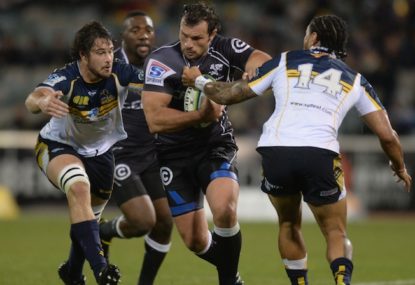Reddog
new author
Roar Rookie

I have a confession to make. I am a rugby tragic, to the extent that I even inserted “permission to watch Rugby, including reruns” into my marriage vows.
The photo of my son Angus and I at the commencement of the 2011 Rugby World Cup is something I will always treasure, as he is rugby’s true stakeholder – the next generation.
In my role as a financial adviser, I regularly see the impact of vested interests and actually wrote about why I thought the Australian Government’s Future of Financial Advice had been hijacked.
Financial planning aside, I am very disturbed to report that I am seeing the same pattern in Super Rugby. How can Super Rugby be like financial planning or why it is being hijacked I hear you ask?
Begin with the end in mind
When assisting our clients to create financial certainty, we always commence the process with their goals, priorities and comfort zones. Only when you have articulated these can you define your strategy.
In the case of Super Rugby, it seems that SANZAR commenced the review with the wrong end in mind.
Super Rugby to be expanded from 15 to 18 teams
A few weeks back it was announced that Super Rugby would expand from 15 to 18 teams, with the overall structure and design of the competition being changed at the same time.
We will now have an additional South African team, one team from Argentina and a tender process for the final team, most likely to come from Asia. The existing competition will be altered to four conferences, which translates to less games between South African, Australian and New Zealand teams, more finals berths for South African teams, and the likelihood that some teams may never have the experience of playing each other.
To those involved in approving this restructure, I ask: “How is this in any way respectful of the investment made to date by Super Rugby fans (the ultimate stakeholders), broadcasters or the remaining foundation partners in the ARU and New Zealand Rugby?”
With a sixth franchise, SA Rugby will receive what they want, along with preferential finals treatment and the economic benefits associated with closer ties to Argentina and the soon to be appointed new team.
In reviewing the new structure, I believe that the issuance of a sixth Super Rugby franchise to SA Rugby by SANZAR was the end goal.
SANZAR have put the desires of SA Rugby before the goals of the collective fans of Super Rugby. Instead of three conferences with five teams each, we will now have two conferences with five teams and two with four teams.
Are you serious? Let’s keep it simple. Here’s a hint to Mr Greg Peters, the CEO of SANZAR – you won’t need to pay millions of dollars to Price Waterhouse or BCG to analyse this, as my son could probably grasp the mathematics and logic.
The Reddog Plan
The Reddog Plan begins with the principle that South Africa, New Zealand and Australia have agreed that they would like to expand the game and that they must each have equal representation in the Super Rugby Competition.
If one party wishes for an additional team, they should use a Premier League-style relegation system until such time as all members wish to or have the required talent pool to expand.
Eighteen teams fits nicely into three conferences of six teams.
1. Fans get it and broadcasters get it.
2. Approve one team each from Argentina, Japan and the Pacific Islands
3. If unsure, refer to point 1.
It’s concise and easy to understand and rewards those that have invested in rugby, most notably the Pacific Islands. In short, it is the right thing to do.
| Conference 1 | Conference 2 | Conference 3 |
| Blue Bulls | NSW Waratahs | Auckland Blues |
| Golden Lions | Queensland Reds | Canterbury Crusaders |
| Eastern Province Kings | ACT Brumbies | Waikato Chiefs |
| Natal Sharks | Western Force | Wellington Hurricanes |
| Western Province Stormers | Melbourne Rebels | Dunedin Highlanders |
| Argentinian Team | Japanese team | Pacific Islands team |
Each team plays all teams in their conference once, and two teams in their conference twice.
Each team plays four teams from the other two conferences once.
To ensure player welfare and reduce travel costs, teams can only travel to Argentina or Japan every other year, and not to each in the same year.
The top two teams in each conference gain entry to the finals, with two wild card entries based on competition points.
If you want to attract supporters from other codes, you need to bring back the geographical reference to each team.
There will no doubt be hundreds of permutations to the above, including having some of the new teams playing in the finals of a Super Club series involving the winners of the ITM Cup, Currie Cup and NRC. All I have sought to do is commence the review process with the right end in mind, and adhered to the view that much like financial planning, rugby should be simple, easily understood, and based on sound principles with proven outcomes.
Leadership often involves admitting that you have made a mistake. To all members of the SANZAR Board, now is the time to display this quality and implement The Reddog Plan.